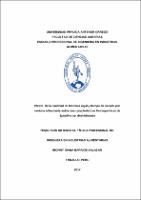Efecto de la cantidad de biomasa algal y tiempo de secado por ventana refractante sobre sus características fisicoquímicas de spirulina sp. deshidratada

View/
Download
(application/pdf: 2.119Mb)
(application/pdf: 2.119Mb)
Date
2017Author(s)
Barrios Salazar, Ibonny Diana
Metadata
Show full item recordAbstract
Se evaluó el efecto de la cantidad de la biomasa algal de Spirulina sp.
cosechada (10 a 30 g) y el tiempo de secado (10 a 30 min) por ventana
refractante, fijándose como el mejor contenido de humedad
aproximadamente 5%, con el mayor contenido de proteína y un adecuado
contenido de ceniza, que no sobrepasen de 10%. Se utilizó un Diseño
Compuesto Central Rotacional y Metodología de Superficie de Respuesta
para once tratamientos experimentales. El cultivo se realizó en un
fotobiorreactor de canal de bucle cerrado-abierto a la atmosfera iluminado
con luz LED con fotoperiodo 12 h de luz/12 h de oscuridad. El secado en
ventana refractante se realizó a 97±2 ºC, con una lámina refractante Mylar
Poliester de 0.1 mm de espesor. Se obtuvieron tres modelos estadísticos
cuadráticos (p<0.05) para el contenido de humedad, contenido de proteína
y de ceniza, con coeficientes de determinación 2 y2 -ajustado, superiores
a 0.85 y 0.75, respectivamente. Se optimizó por superposición de contornos una humedad de 5.09%, proteína de 63.16% y ceniza de 7.89% con la cantidad de la biomasa algal y el tiempo de secado de 23.65 g y 22.03 min, respectivamente. The effect of the quantity of the algal biomass of Spirulina sp. harvested (10
- 30 g) and drying time (10 - 30 minutes) by refractance window (RW), was
investigated setting approximately 5% as lower moisture content, a higher
percentage of protein and less than 10% of ashes. A Rotational Central
Composite Design (RCCD) and Response Surface Methodology (RSM)
were used for eleven experimental treatments. The cultivation was
performed in a closed-loop channel photobioreactor open to the atmosphere
(CL-CPOA) illuminated with LED light in a photoperiod of 12 hours of light/
12 hours of darkness. The drying in RW was performed at 97 ± 2 °C, with
of a 0.1 mm thick Mylar Polyester refracting film. Three quadratic statistics
models were obtained (p<0.05) for moisture content, protein and ash, with
a coefficient of determination R 2 y R 2 -adjusted superior to 0.85 and 0.75, severally. A moisture content of 5.09%, 63.16% protein and 7.89% ash were optimized by an overlap of contours with the algal biomass and drying time of 23.65 g y 22.03 minutes respectively.
Subject
Collections
- Industrias Alimentarias [152]

